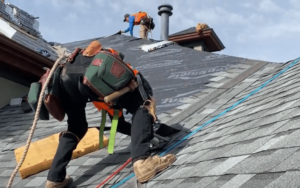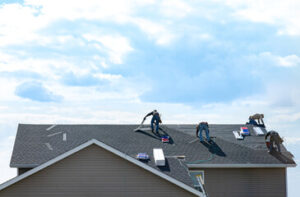The roof is an important part of your home that protects it from the elements. It can be flat or pitched, vaulted, or domed.
The sheathing is the wooden boards that form the base of your roof. It used to be made up of elongated planks, but today, most roofs are built with plywood sheet sheathing. Click the Roofing Golden to learn more.

Whether you’re building a new home or replacing your existing roof, the type of materials used will significantly impact your roofing costs and the overall look and performance of your house. From traditional asphalt shingles to clay and metal tiles, there are many options available to suit your budget, aesthetic preferences, and environmental concerns.
Historically, roofing was made from layers of sticks, leaves and clay shaped into pitches or sloping surfaces that shed water away from the house. As technology advanced, so did the variety of roofing materials. Asphalt shingles are the most common roof coverings, striking a balance between performance and initial cost. They are durable and readily available, with a warranty period that can exceed 25 years.
More costly but long-lasting options include slate, tile and metal roofing. Clay tiles are fired in kilns to create dense, water-resistant coverings that can either lay flat or follow a wavy pattern. They’re also highly resistant to high winds, making them a good choice for coastal and desert regions.
Slate is a natural material that can add a unique aesthetic to your home. It’s heavy, however, so it requires strong and stable roof structures to support it. The material also needs to be properly maintained to ensure it lasts for a long time.
Both shingles and shakes can provide your home with a rustic look. Shakes are split from the log and shaped, while shingles are sawn into thin wedges for a more even finish. Both are less expensive than other options but do require regular maintenance to keep them in good condition.
Another popular option is built-up roofing (BUR), which consists of layers of felt or ply sheets with bitumen in between them. It’s a common choice for flat or low-slope roof styles and has an excellent Class A fire rating. The downside to BUR is that it can release unpleasant odors during installation and may be more susceptible to damage from foot traffic or hail than some other materials.
Sheet steel roofing is typically galvanised or coated with zinc/aluminium/zinc (Zincalume) or aluminum/zinc/aluminum/zinc (Colorbond). These products are light, durable and offer a good level of energy efficiency. They can be screwed or nailed to timber battens, or clipped into concealed brackets. Most steel roofing contains recycled content and is easily recyclable, so it’s an environmentally responsible choice.
Installation
A roof is an integral component of any structure and acts as its main barrier against weather elements. Its various parts protect against rain, snow, sunlight, extreme temperatures, and wind. Roofing is available in a variety of styles and materials, each with its own strengths and weaknesses. Your contractor will help you select the best roofing material for your home or commercial space based on aesthetic and budgetary concerns. He will also explain the installation process and answer any questions you may have.
During the actual roofing process, your contractor will begin by laying down a strip of underlayment on the surface. The underlayment is a layer of felt paper or another waterproof material that protects the roof deck from water damage. The contractor will then attach the first row of shingles to the underlayment, overlapping each one by six inches. The next row of shingles will be placed on top, aligned with the previous row and fastened with cap nails every four to six inches. The cap nails will be spread out more towards the middle of the shingle to ensure that it is securely attached. The contractor will repeat this pattern until the ridge of the roof is reached.
Your contractor will then install flashing to prevent leaks in the eaves, roof valleys, and along the hip roof edges. He will also use it around chimneys, wood stove pipes, vents, and other roof penetrations. He will seal these with roofing cement and replace any old caulking as needed.
Re-roofing your building will increase its value and protect it from rain, hail, sun, and extreme temperatures. It will also help you save on energy costs by improving attic ventilation and regulating indoor temperature. To ensure the integrity of your new roof, it is important to hire a qualified and experienced contractor.
Maintenance
Regular inspections and cleaning procedures help maintain the integrity of a roof. This helps prevent leaks, deterioration, and other issues that can decrease the life of the roofing material and lead to expensive repairs. Maintenance procedures include:
Checking for Leaks: This can be done by visually examining the surface of the roof for signs of water damage, including mold and mildew, as well as checking for visible stains on interior ceilings and walls. This can also be done by simulating rain or running a water hose across the roof surface to look for any areas where water may flow down and collect.
Clearing Debris: This includes removing any dirt, leaves, or debris from the roof surface to avoid clogging and protect the roofing materials from premature deterioration. In addition, it is important to regularly check for falling tree limbs that could puncture or otherwise damage the roof. Regularly clearing gutters and downspouts can help ensure they are free from blockages that can impede water flow, as well.
Examining the shingles for excessive wear and tear or any that are outright missing. Look for holes and dents in the shingles as well, as these can allow unwanted creatures to enter the home or business. It is also a good idea to inspect for any cracks or gaps in the flashing, which are the areas where the chimney and vent pipes meet the roof.
Removing Algae and Moss Growth: These organisms can retain moisture, leading to shingle deterioration over time. Removing these growths will help to prolong the life of the shingles.
Inspecting and Repairing Rooftop Equipment Supports: This includes ensuring rooftop HVAC units, solar panels, or other equipment are supported properly to avoid structural damage or a lack of proper air circulation. Coating and Sealant Application: Applying protective coatings and sealants will enhance the durability, weather resistance, and energy efficiency of a roof.
At GR, we have a dedicated roofing team that will perform the necessary maintenance to keep your building or home’s roof in optimal condition. We can provide scheduled inspections, cleaning, and repair services as needed to extend the lifespan of your roofing system. Contact us today to learn more about our programs and schedule your appointment.
Repairs
Whether it’s repairing an isolated leak or replacing a section of shingles, roof repair requires careful assessment and attention to detail. It’s also important to consider the local climate and whether or not the existing shingles are rated for high winds. In some cases, re-roofing may allow property owners to upgrade to a material that improves energy efficiency or increases property value.
To assess what’s needed, the first step is to go up in the attic or crawl space – whatever access point you have that allows you to see the inside of the roof. Look for damp stains, any sign of standing water and the state of the beams.
If you see any areas that need to be repaired or replaced, make them a priority. It’s always better to catch small problems before they become bigger ones that could require full replacement. The same goes for any ventilation issues you may need to address.
